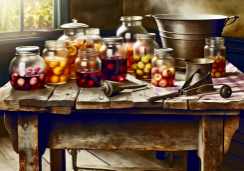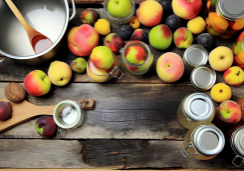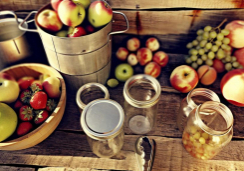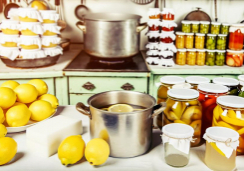Abandon Hope: French Cooking Techniques Too Complex for Amateurs
You've likely heard the rumor that French cooking techniques are far too intricate for the casual home chef, but have you ever put that theory to the test?
Consider the art of crafting a flawless consommé, which demands a level of finesse and patience that might make you question your culinary pursuits. You're faced with a myriad of complex methods, from mastering the delicate balance in pâtisserie to the precise timing of a soufflé — not to mention the rigorous discipline required in charcuterie.
These techniques, steeped in tradition and exacting standards, could indeed seem insurmountable. Yet, before you hang up your apron, ask yourself if there's a certain thrill in conquering what's often reserved for the pros. Could there be more to this culinary challenge than meets the eye?
Stay with me as we slice through the layers of these daunting gastronomic feats to uncover if they truly are a siren call for the amateur, or if they beckon a journey toward culinary greatness.
Mastering the Art of Consommé
To truly elevate your culinary prowess, it's essential to master the art of consommé, a clarified broth renowned for its intense flavor and elegance in French cuisine. This quintessential French culinary achievement demands precision and a firm grasp of culinary techniques, particularly clarification.
Crafting a stellar consommé isn't merely about simmering bones or vegetables for hours on end; it's an intricate ballet of flavor extraction and impurity removal. The process begins with a rich stock, simmered to coax out deep, robust flavors. Yet, the crux lies within the clarification phase, where the broth must be meticulously strained until it achieves a crystal-clear appearance and pure taste. This isn't a task for the hurried or heavy-handed. It requires a gentle touch and unwavering attention to detail.
Achieving the perfect consommé is a testament to your technical skills and understanding of French culinary practices. It's a delicate balance, where one misstep could cloud the broth or dilute its essence. You're not merely making soup; you're engineering a sophisticated dish that can only stand tall when every element is executed flawlessly. It's a relentless pursuit of perfection, embodying the spirit and demands of high French cuisine.
Intricacies of Pâtisserie Perfection
Why stop at savory when the world of French pâtisserie beckons with its intricate pastries, each demanding a precise blend of artistry and technical skill? You might think mastering a white sauce like Beurre Blanc is the pinnacle of complexity, but pâtisserie requires an even finer touch.
Imagine the parchment-lined trays, the delicate balance of flavors needing the tart kick of lemon juice to elevate them beyond the ordinary.
Your chef's knife, so adept at dicing shallots for that Beurre Blanc, is virtually useless here. In pâtisserie, precision isn't just recommended; it's non-negotiable. A millimeter off in your pastry dough or a second too long in the oven, and your creation is compromised.
You're not just cooking; you're engineering edible art. Consider the temperamental nature of chocolate, the fickleness of puff pastry, and the volatility of meringue. These aren't the forgiving mediums of home cooking. They're the canvases for professionals who've dedicated years to perfecting their craft.
Amateurs often lack the nuanced palate required to discern when a touch more lemon juice is needed, or the practiced hand to fold dough with the care it demands. Pâtisserie perfection is a lofty goal, indeed—one that might just be out of reach for the casual home chef.
The Daunting Soufflé Challenge
Mastering the soufflé stands as a rigorous test of your culinary precision and patience, challenging even the most dedicated amateur chefs with its demand for flawless technique. At the French Culinary Institute (FCI), where expectations soar high, you're not only grappling with the complexities of French terminology but also the stern oversight of an old-school French chef in a class that tolerates no slacking off.
Consider the soufflé: achieving that quintessential rise requires eggs at room temperature, separated with none of the yolk trespassing into the whites. A bit of water may be added for stability, but it's a delicate balance. You must whip the whites to soft peaks — not too stiff, not too soft. The butter, cut into small pieces, must seamlessly blend without deflating your painstakingly beaten whites. And then there's the oven preparation, where a piece of parchment can mean the difference between success and a deflated disaster.
To deepen your understanding, consider these critical points:
- Room temperature ingredients ensure even cooking.
- Small pieces of butter incorporate better.
- A bit of water can stabilize egg whites.
- A piece of parchment assists in even heat distribution.
- Precision in folding is non-negotiable for the perfect rise.
In this analytical vein, it's clear: the soufflé isn't for the faint-hearted.
Precision in Charcuterie Crafting
How can you ensure your charcuterie rivals the quality of a seasoned artisan's? Mastery of French cooking demands not just flair but also meticulous precision. In the realm of charcuterie, every minute detail, from the blend of spices to the exact temperature for curing, can make or break the final product. You can't simply eyeball measurements or tweak cooking techniques based on intuition. Instead, you must adopt a scientific approach to food preparation.
To start, the selection of ingredients isn't something to be taken lightly. Each spice and seasoning must be measured with exactitude to achieve the harmonious balance essential in charcuterie. Overlook this, and you'll never replicate the nuanced flavors of French cooking. Moreover, you must understand the nuances of different cuts of meat and how to trim the remaining fat and sinew to ensure proper curing and texture.
Temperature control, too, is a critical factor that can't be underestimated. A few degrees too high or low during the curing process, and you might as well discard your efforts. The aging of charcuterie is an art in itself, requiring not just patience but also strict adherence to time-tested techniques. Without these, the desired flavor and texture profiles remain elusive, and your charcuterie falls short of authentic French standards.
The Ballet of Chateaubriand Technique
Executing the Ballet of Chateaubriand Technique requires you to deftly trim and tie a beef tenderloin, a testament to your precision and culinary prowess. It's not just about having a pretty good idea of what you're doing; this method is an intricate performance that demands your undivided attention. On your cutting board, every slice must be deliberate, every knot precise. You must make sure the beef cooks evenly, transforming it into a masterpiece of tenderness and flavor.
Analyzing this technique reveals layers of complexity:
- Precision Cutting: Trimming excess fat without compromising the tenderloin's shape.
- Tying Mastery: Ensuring uniform thickness for even cooking.
- Temperature Control: Mastering the sear and internal temperature.
- Time Management: Coordinating the cooking process to peak at the right moment.
- Sauce Perfection: Crafting a sauce that's worthy of accompanying such a fine cut.
Frequently Asked Questions
Why Is French Cuisine so Complex?
French cuisine's complexity lies in sauce mastery, precision timing, and respecting ingredient terroir, deeply rooted in culinary history. You'll find its exacting standards challenging but not insurmountable with dedication and practice.
Why Is French Cooking so Hard?
French cooking's difficulty lies in the culinary precision, ingredient intricacy, and the significant time investment required. You must master complex techniques, which demands patience and a deep understanding of the culinary arts.
What Is the Most Complicated French Dish?
You'll find dishes like Coq au Vin require ingredient mastery, precise timing, artistic plating, and knowledge of regional variations to truly master—making it one of the most complicated French dishes to perfect.
What Was Julia Child's Famous Phrase?
Julia Child's famous phrase, "Bon Appétit," embodies her culinary pedagogy and cooking philosophy. It reflects her influence on television, inviting you to delight in food with gusto and an open heart.
Conclusion
You've braved the labyrinth of French gastronomy, from the clear depths of consommé to the airy peaks of soufflés. Each precise cut and measured mix has tested your resolve.
Yet, despite the rigors of pâtisserie and charcuterie, or the dance of Chateaubriand, you've emerged more than an amateur.
The journey's tough, demanding unwavering dedication. But don't let the complexity deter you; it's this very intricacy that sharpens skills, refining your culinary prowess to a professional sheen.










